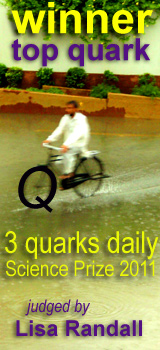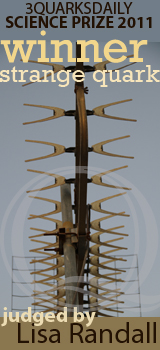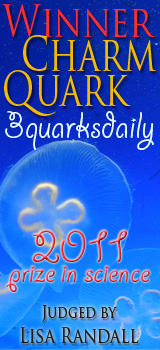


Lisa Randall has picked the winners:
1. Top Quark, $1000: SciCurious, Serotonin and Sexual Preference: Is It Really That Simple?
2. Strange Quark, $300: Anne Jefferson, Levees and the Illusion of Flood Control
3. Charm Quark, $100: Sean Carroll, The Fine Structure Constant is Probably Constant
3. Charm Quark, $100: Ethan Siegel, Where Is Everybody?
As you can see, for the first time, there is a tie for third place and the money for the charm quark has accordingly been split between the two 3rd place winners.
Here is what Professor Randall had to say about them:
I have a confession to make. I’m relatively new to the social media science world. I’ve joined Twitter (@lirarandall) but use it for many purposes, only some of which involve disseminating science (in 140 characters or less). Bloggers on the other hand, have an online presence that can take on issues in depth. I aim for that in books where I try to present an entire story. Blogs do this in pieces, primarily reporting on issues of current interest and giving a nugget of information that can help enlighten the reader about a particular subject, but also about a way of thinking.
All the finalists to this year’s competition were really good– so good in fact that judging was a challenge. So I tried to focus my judging on one of the major purposes of blogs—to give the news that more traditional sources are not necessarily providing. Yes blogging might get to some issues faster, but one of the real values of blogging is that there can be slightly longer and more in-depth reporting by people who are more knowledgeable and won't shy away from actual science.
My first choice is Scientific American’s guest blog, Serotonin and Sexual Preference: Is It Really That Simple? SciCurious took on the issue of why scientific studies can be technically well-designed yet demonstrate something entirely different from what the authors claim. This piece was actually good science in itself—science that the authors themselves, not to mention some of the media, failed to properly understand. From the perspective of considering all possible theories that would account for the results and recognizing the complexity of the brain, which can be only addressed in small pieces by such simple mouse studies, this piece was excellent. My hope is that such blogs will temper the overblown claims that biological studies often report based on limited evidence.
I very much liked Anne Jefferson's piece in Highly Allochthonous, Levees and the Illusion of Flood Control, which is my second choice. I was a little hesitant in that there is less science per se than some of the other blogs, but I have to say that I learned a lot. It was interesting hearing about both someone’s personal experience and more in-depth investigations into the subject. Differentiating the vantage points of people in a well-developed community, people more spread out along a river, and those of us nowhere nearby who just want things to be stabilized was good and thoughtful reporting. Also the recognition that levees are only one part of the issue—but one worth understanding.
For third place I am going to defer a little. Physics is my field—particle physics and some cosmology in particular—and I am wary about letting that color my view. But both Starts With A Bang’s Where Is Everybody? and Cosmic Variance’s The Fine Structure Constant is Probably Constant did a good job of explaining slightly more esoteric phenomena. My colleague Sean Carroll took on the challenge of elucidating the nature of a field and minimizing potential energy for such a field. Explaining the unintuitive notion of a field in understandable terms was something he did admirably. Ethan Siegel took on the challenge of simplifying probability estimates without sacrificing the nature of the enterprise or suppressing the uncertainties involved. What was so great about the latter exercise was that it allowed you to see how science can yield valuable insights, even when there are uncertainties, and how good predictions often require more than a single input piece of information. And he didn’t shy away from numbers—albeit nice round ones that most people will understand. In both these respects I’m also going to give a shout-out to the non-nominated blog, The Reference Frame. I don’t always agree with everything he says but Luboš Motl does a tremendous job of bringing a wide variety of physics topics to the public.
The above blogs are well-deserving of their prizes. But as I said earlier, all the blogs were a pleasure to read. Keep up the good work and we might eventually get a scientifically literate populace.
Congratulations also from 3QD to the winners (I will send the prize money later today or tomorrow–and remember, you must claim the money within one month from today–just send me an email). And feel free to leave your acceptance speech as a comment here! And thanks to everyone who participated. Thanks also, of course, to Lisa Randall for doing the final judging.
The three prize logos at the top of this post were designed, respectively, by me, Sughra Raza, and Carla Goller. I hope the winners will display them with pride on their own blogs!
Details about the prize here.
As a boy, D.J. was a promising student. He had received a scholarship to study English at the University College of Wales at Aberystwyth where he graduated with first-class honors. Like many promising students of English, D.J. had dreams of being a poet. Instead, he became a grammar school teacher. He watched in anger and shame as colleagues of clearly inferior worth gained appointments to higher university positions while he remained where he was. D.J. was often ill, and wondered why he had no visitors. He cultivated a devastating schoolmaster’s sarcasm that shielded his fragile pride. Students of Schoolmaster Thomas remember an unforgiving tyrant who cursed stupid boys and dirty boys. But he made Shakespeare come alive and became known for getting his boys into Oxford and Cambridge. D.J.’s great passion for English literature was available for any boy willing to receive it. To his son Dylan, however, the clever, disappointed father gave his entire dream of a poet’s life.
